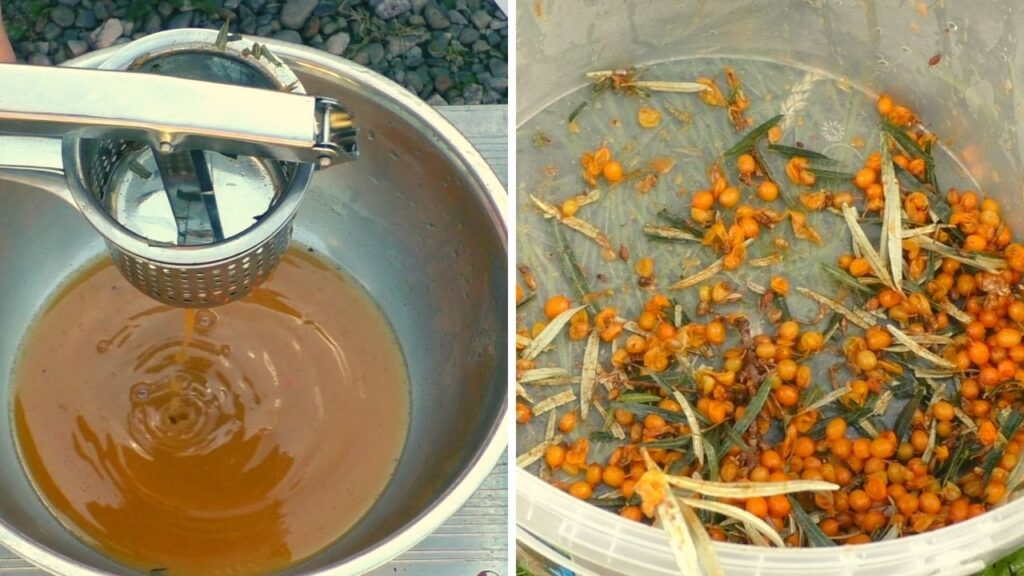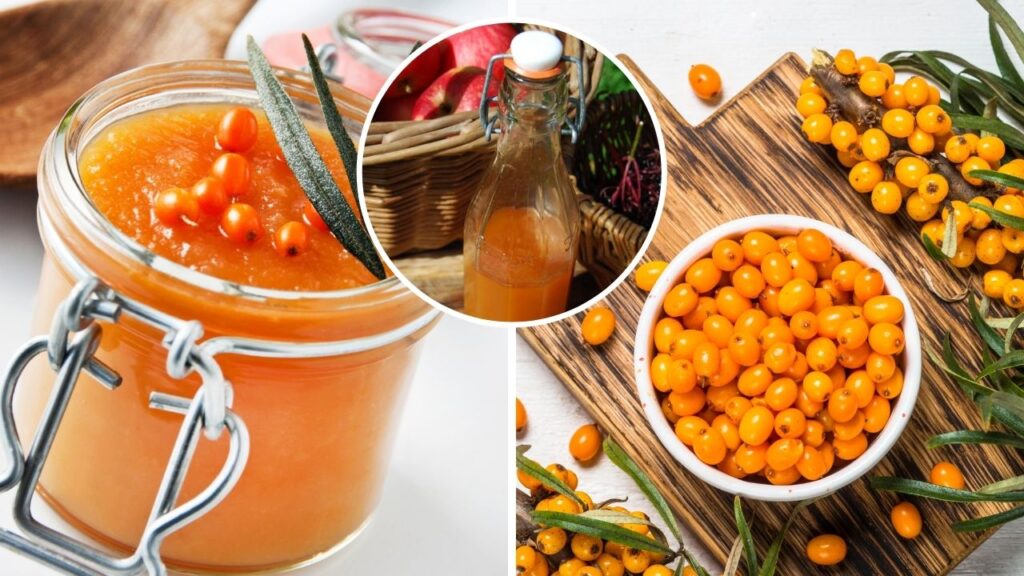How To Forage Sea Buckthorn – Nature’s Superfood
Sea buckthorn (Hippophae rhamnoides) is one of our littlest known but most beautiful trees. Not only do they give a stunning display of colour, the berries sure do pack a tropical punch. The juice has to be one of the most memorable and refreshing flavours in the wold of UK wild food. When they fruit, the combination of the bright orange berries against the silvery green leaves make them look almost Mediterranean. So, if you want to feel like you’re kicking back on a sunny beach with a tropical drink in the depths of winter, we’ll give you the closest thing with some delicious sea buckthorn recipes. It’s a a wild food that’s well worth getting to know.
Getting these berries off the tree can be a little troublesome. You might have guessed from the name of this tree that there’s thorns to deal with. I’m here to help though and I’ve included a video which shows the easiest ways I’ve found to harvest the berries. You’ll get tips and tricks to filtering out leaf debris, so give it a watch. These are tried and tested methods so you can see how well each works for yourself.
If you’ve watched the video you might be thinking; “that seems like a lot of work for some fruit juice.” But the nutritional benefit of these little gems is unbelievable! They truly are a superfood. They contain high levels of vitamin C, around 5 times more than oranges, high levels of antioxidants as well as omega 3 and 6. Importantly they contain A, B, C and E vitamins including B12. Scientific trials have found that sea buckthorn is effective in treating tumours, lung diseases and gastric distress. They also help reduce inflammation and can treat heart diseases and improve blood vessel function, so get drinking it!

Above: This female sea buckthorn was found in an old sand & gravel quarry, far from the coast.
Where & When Can I Find Sea Buckthorn
Finding one of these amazing trees is not always the easiest thing. They are not nationally common, but could be locally common in your area. Generally, sea buckthorn is restricted to coastal areas or particularly gravelly soil so if you’re near a beach make sure to have a scout around as they have been purposely planted in many areas to help stabilise sand dunes. With that in mind they can also sometimes be found planted up in retail parks and roadside verges where they provide that stabilisation for the ground but also quick ground cover. Keep your eyes peeled.
Sea buckthorn is a deciduous shrub that has silvery-green leaves similar in appearance to rosemary. The leaves also remind us of a smaller version of willow leaves. The shrub also grows thick spines along the branches which is a good indicator of the species into the winter when the leaves fall.
The dense clusters of bright orange berries are a dead giveaway to positive identification. Look for a silvery sheen close up on the berry skins too. The berries begin to fruit around August and September but it’s best to leave them till they’ve all turned from green to orange. As you’ll see from my video, early to mid autumn is the best time of year to harvest the berries as they are more firm and will get damaged less when picking. The later in the season you go, the more delicate the berries become. You can still harvest them into late autumn/early winter but it will be a messier job as the juice gets everywhere.
This tree is dioecious, which means it has separate male and female trees. Only the females produce the berries. So, don’t be surprised if you come across a specimen in the right season but with no berries. Look around the surrounding area for a female in fruit.

Above: Notice the leaves grow in a whorl around the whole twig. They have a silvery sheen to them.
How do I Process Sea Buckthorn
As the name suggests the sea buckthorn is a spiny shrub so a thick pair of gloves is helpful for one of the methods of collecting the berries. When the berries are ripe they tend to burst very easily, which does make collecting them a little tricky, but we’ve got some proven methods to remove the berries that we’ve tried so you don’t have to.
The first method, which I prefer, involves cutting off the tips of branches which are heavy with berries. Although this can seem quite destructive, this is a tree which grows back fast, so you can cut with confidence. It’s good practise to always take only what you need and leave what you can for wildlife.
- Pop the cut branches in a bag.
- When you’re home, put the branches on a tea towel outdoors, in a place where creepy crawlies can escape.
- Later, place the berry-heavy bunches in a double layered bin bag and leaving in the freezer for a couple of days.
- Once the berries have fully frozen remove the bin bag and beat it with a stick, this will separate them from the branch without bursting them.
- Lastly you’ll need to separate the whole berries from any other debris that has been loosened in the bag. Watch the video for tips on how to do this effectively.
The second method is a little messier but is a quick way of collecting the juice of the berries. This method is best done later in the season when the berries are at their ripest.
- Put a clean food bucket under the branch you want to collect the juice from.
- Wearing a thick pair of rubber gloves, squeeze along the branch in a downward motion, toward the tip. This squishes the berries as you go and avoids you getting spiked. The juice runs into the bucket below.
- When you get home, the juice will need straining as lots of leaf and branch debris will probably fall into the bucket during the collection process.
With either of these methods, make sure you’re not wearing anything you would mind getting berry juice on or even wear an apron.

Above: Using the “bag & freezer” method to separate the berries.

Above: Processing the juice from the berries. I used a potato ricer.
What Can I Make with Sea Buckthorn
Sea buckthorn has a notoriously tart taste so I would recommend sweetening it before eating, unless you like an intense sharp and sour hit – I dare you to give it a try raw. If you want to get an idea of the kind of sharp citrusy flavour the processed juice of the berry gives then pick one straight from the tree, it’s very refreshing… if a little tart. The recipe I made was a sweet sea buckthorn juice and it was a very refreshing and very healthy addition to my breakfast.
For this recipe you can get away with using the squeeze method as mentioned above, as all you really need is the juice. Make sure you strain the juice through a sieve or muslin cloth if you want to be super thorough. You will need:
- Sea buckthorn juice
- Runny honey to taste
- A sterilised container with a lid for storage
In a saucepan, heat the juice and honey together on a low heat. Stir well to make sure the honey melts into the juice. When the juice is as sweet as you want, take the pan off the heat and leave to cool before bottling in a sterilised jar.
As well as complimenting your morning eggs you could try adding the juice to some sparkling white wine to make sea bucks fizz, or with lemonade to make a refreshing cordial. You could also consider using sea buckthorn for jam, or you could reduce the juice by cooking it for longer and adding sugar to make a sea buckthorn syrup. In Northern Europe, it’s popular as an accompaniment to fish as it is similar in sharpness to lemon.
Making a fruit leather would be a good way of preserving the goodness of the berries right through the year. To do this; gently simmer the juice down to a thick syrup, combine it with hawthorn berry pulp which has been similarly boiled down, spread the mixture thinly onto greaseproof paper and then dry it over several hours gently in a dehydrator, on an oven on a low heat with the door slightly ajar to allow airflow. The purpose of the hawthorn berries (called haws) is to provide a binding quality to the leather, as on its own the buckthorn juice may struggle to hold together. The haws also have their own major health benefits. A fruit leather not only preserves the vitamins but hold the taste too.

Above: The juice or berries can be used to make a range of tangy foods like jam, sauce, cordial or fruit leather.
Discover More Wild Food
If all this talk of wild food and foraging has whetted your appetite then you can take your learning further with us through the range of courses we offer.
You can immerse yourself in the world of foraging through our outdoor courses hosted in beautiful National Trust estate woodlands in North-East Wales. Or if that’s too far afield for you we also host regular online workshops, live through Zoom where we focus on wild foods of the season and give you delicious recipe ideas, foraging tips and expertise from special guest speakers. If this all sounds interesting, check out what’s coming up on our Events page right here.
Another way to get instant access to a whole backlog of wild food & foraging videos, recipes and recorded workshops is to join our Tribe over on Patreon. In return for supporting our mission, our patrons get access loads of exclusive resources. You can join the Tribe from as little as £3.60 per month. Find out about all the benefits right here.
Until next time, good luck with your own foraging journey.
James

